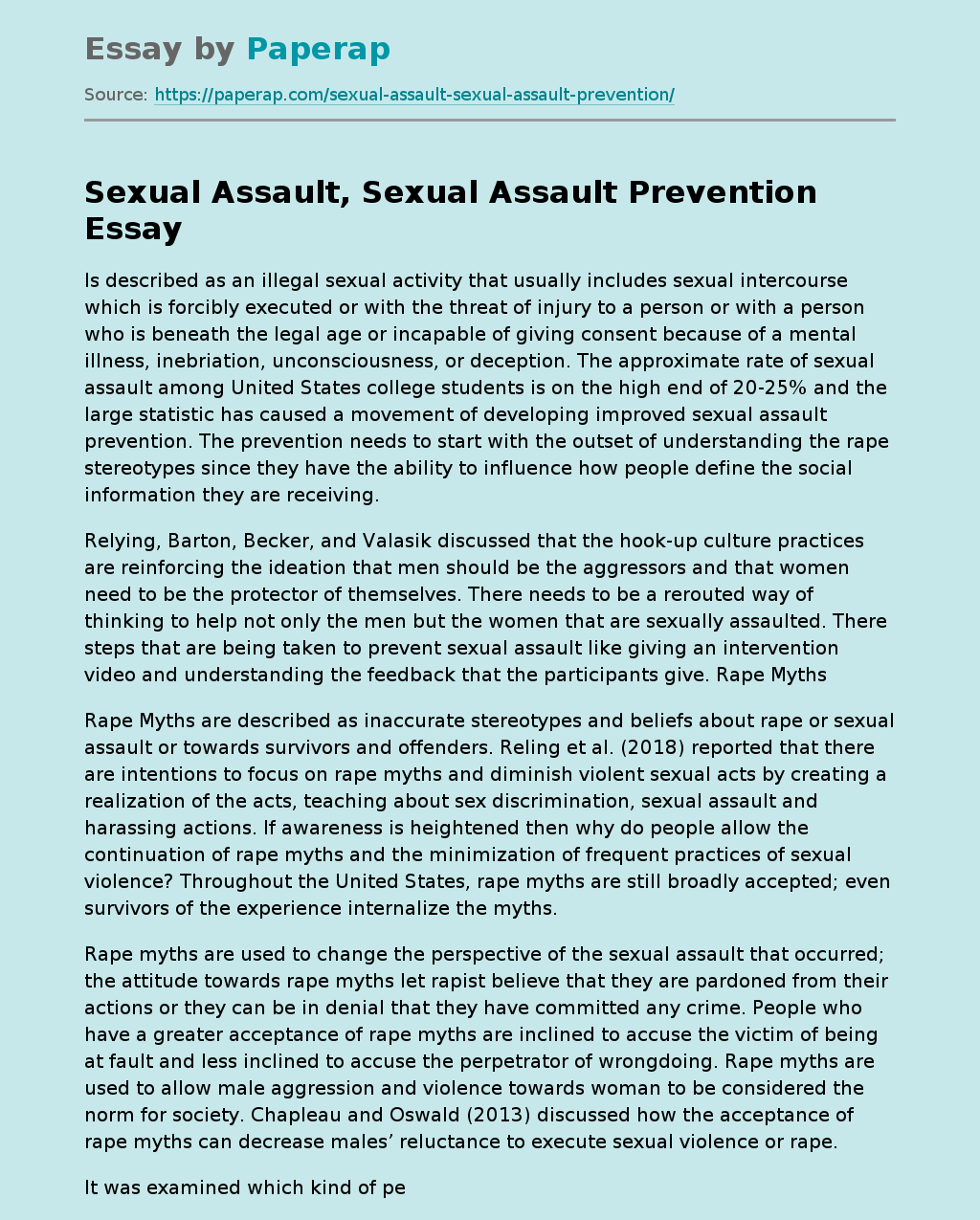Is described as an illegal sexual activity that usually includes sexual intercourse which is forcibly executed or with the threat of injury to a person or with a person who is beneath the legal age or incapable of giving consent because of a mental illness, inebriation, unconsciousness, or deception. The approximate rate of sexual assault among United States college students is on the high end of 20-25% and the large statistic has caused a movement of developing improved sexual assault prevention.
The prevention needs to start with the outset of understanding the rape stereotypes since they have the ability to influence how people define the social information they are receiving.
Relying, Barton, Becker, and Valasik discussed that the hook-up culture practices are reinforcing the ideation that men should be the aggressors and that women need to be the protector of themselves. There needs to be a rerouted way of thinking to help not only the men but the women that are sexually assaulted.
There steps that are being taken to prevent sexual assault like giving an intervention video and understanding the feedback that the participants give. Rape Myths
Rape Myths are described as inaccurate stereotypes and beliefs about rape or sexual assault or towards survivors and offenders. Reling et al. (2018) reported that there are intentions to focus on rape myths and diminish violent sexual acts by creating a realization of the acts, teaching about sex discrimination, sexual assault and harassing actions. If awareness is heightened then why do people allow the continuation of rape myths and the minimization of frequent practices of sexual violence? Throughout the United States, rape myths are still broadly accepted; even survivors of the experience internalize the myths.
Rape myths are used to change the perspective of the sexual assault that occurred; the attitude towards rape myths let rapist believe that they are pardoned from their actions or they can be in denial that they have committed any crime. People who have a greater acceptance of rape myths are inclined to accuse the victim of being at fault and less inclined to accuse the perpetrator of wrongdoing. Rape myths are used to allow male aggression and violence towards woman to be considered the norm for society. Chapleau and Oswald (2013) discussed how the acceptance of rape myths can decrease males’ reluctance to execute sexual violence or rape.
It was examined which kind of people are more likely to accept rape myths and they found that female students are less likely compared to their male counterparts. Status in today’s society matters and where you lie in the social hierarchy will alter how likely someone is to accept rape myths. Relying at al. (2018) found that individuals who believe hookups are innocent acts or increase status deem rape myths more truthful, but people who find hookups as a privilege of sexuality are less likely to deem rape myths as truthful. Hook-up Culture Hook-up culture is casual sexual encounters that include a broad variety of sexual behaviors between people. Relying et al went in-depth when they discussed that hook-up culture and rape myths have many common factors that tie them closely together.
They include the normalcy of men being the dominant pursuer or the aggressor of the sexual relationship and the woman being the protector of her own self. Reling et al. (2018) described how men are more likely to affirm rape myths and engage in hook-up culture. Hook-up culture has ramifications on the social and emotional aspects of life, particularly females. Heldman and Wade (2010) described that the commonplace for a casual sexual encounter is at parties. The encounter begins with communication, spoken and unspoken, to show a mutual interest in each other. Heldman and Wade (2010) explained how the two people involve themselves in the intimacy of each other in a private to a semi-private place.
Men who have an abundant amount of sexual encounters are glorified while women who participate in the same activities are shamed and looked down upon. “Hook-up culture facilitates sexual assault”. College students have reported that there is an association of where hook-up behaviors occur and sexual assault. The prevalence of sexual assault, both men and women, rises in people who engage in hook-up culture compared to those who restrict themselves from those activities; approximately one-fourth of undergraduates that have reported hooking up have also disclosed that they have been raped. Risk Factors A public wellness problem on higher-level institutions is sexual assault and the rate of sexual assault is as significant as twenty to twenty-five percent.
The highest form of sexual victimization, reported by undergraduate students, is undesirable sexualized touching and pressure to perform sexual attacks. There are many different aspects about someone that may lead them to have a considerable chance of being raped or sexually assaulted. Women have substantially higher rates of encountering any kind of sexual assault compared to men on college campus’ Roughly one in five females who attended college have encountered a sexual assault experience; men reported about one in eight have experienced a type of sexual assault. People who reported having hook-up’s, men and women, are in a considerable inclined to be sexually assaulted than people who do not report having hook-up’s. Mellins et al. (2017) explained that across the genders, the most reported act committed, percentage-wise, was sexualized touching. Compared to sophomore, junior and senior classifications freshmen are at a larger risk of any kind of assault.
Sexual Assault, Sexual Assault Prevention. (2021, Dec 14). Retrieved from https://paperap.com/sexual-assault-sexual-assault-prevention/

